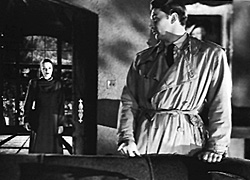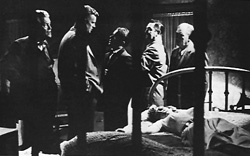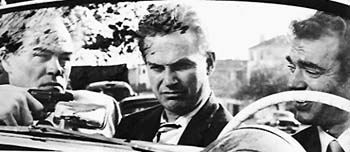













|
|
Unlike other forms of cinema, the film noir has no paraphernalia that it can truly call its own. Unlike the western, with cattle drives, lonely towns on the prairie, homesteading farmers, Winchester rifles, and Colt 45s, the film noir borrows its paraphernalia from other forms, usually from the crime and detective genres, but often overlapping into thrillers, horror, and even science fiction (as in the great "what's it" box from Kiss Me Deadly). The visual style echoes German expressionism, painting shafts of light that temporarily illuminate small chunks of an ominous and overbearing universe that limits a person's chances to slim and none. For as Paul Schrader said in his influential "Notes on Film Noir" essay, "No character can speak authoritatively from a space which is continually being cut into ribbons of light."
Out of the Past, for example, is one of the archetypal noirs, giving us a protagonist who has tried to escape his past (he betrayed a partner by running away with his girlfriend), but fate won't let him escape. He inhabits a world that constantly pulls people back into a morass of existence that is bound to suffocate them. Jeff (played by Robert Mitchum) is a seemingly good guy, but one bad turn has made his life a hell that he can never completely escape. Kirk Douglas plays the racketeer who needs to use Jeff and he does so by planting one of the great femmes fatales, Jane Greer, within Jeff's easy reach. And she consumes him.

Jane Greer and Robert Mitchum in Out of the Past.
The femme fatale would play a crucial role in the film noir, whether in the guise of Jane Greer in Out of the Past, Rita Hayworth in Lady From Shanghai, Veronica Lake in The Blue Dahlia, Joan Bennett in Scarlet Street, Peggy Cummins in Gun Crazy, Gloria Grahame in Human Desire, Lizbeth Scott in Dead Reckoning, Ava Gardner in The Killers, or Barbara Stanwyck in Double Indemnity. These women were black widows who slowly drew in the heroes with come-hither looks and breathless voices. Communicating a danger of sex that is worthy of the '90s AIDS epidemic, the femme fatale knew how to use men to get whatever she wanted, whether it was just a little murder between lovers (as in Double Indemnity) or a wild, on-the-run lifestyle (as in Gun Crazy). The femme fatale was always there to help pull the hero down. And in the case of Mildred Pierce, we even get a femme fatale in the form of a daughter who threatens to destroy her mother's life.
Heroes in the film noir world would forever struggle to survive. Some of the heroes learned to play by the rules of film noir and survived by exposing corruption, such as Humphrey Bogart in The Big Sleep and Dick Powell in Murder, My Sweet. But more often than not, they were the saps destroyed by love (Fred MacMurray in Double Indemnity and Edward G. Robinson in Scarlet Street), a past transgression (Robert Mitchum in Out of the Past), or overly ambitious goals (Richard Widmark in Night and the City and Sterling Hayden in The Killing).

Sterling Hayden and his gang in The Killing.
Titles like Pitfall, Nightmare, Kiss of Death, and Edge of Doom describe what you'll find in film noir. And titles like Night and the City, Side Street, Hell's Island and The Asphalt Jungle convey the terrain. But maybe it's titles such as The Big Heat and The Big Sleep that most simply convey the film noir essence--an overpowering force that can't be avoided.
Film noir first appeared in the early '40s in movies such as Stranger on the Third Floor (often cited as the first full-fledged noir) and This Gun For Hire. While soldiers went to war, film noir exposed a darker side of life, balancing the optimism of Hollywood musicals and comedies by supplying seedy, two-bit criminals and doom-laden atmospheres. While Hollywood strove to help keep public morale high, film noir gave us a peek into the alleys and backrooms of a world filled with corruption. And film noir remained an important form in Hollywood until the late '50s. Films such as Touch of Evil (1958) closed out the cycle. By then, the crime and detective genres were playing out their dramas in bright lights, with movies such as The Lineup containing noir elements but not the iconography of darkened streets and chiaroscuro lighting. (Post-'50s noirs such as Farewell, My Lovely and Body Heat are nostalgia first and noirs second.)
In this issue's "In Focus," we give you a look at 10 different film noir classics. These are some of the essential noirs, movies that we strongly recommend, movies that all movie buffs should be familiar with. We invite you to test out the links below and witness the various shades of noir. In addition, Alain Silver reveals the truth about the ending of noir classic Kiss Me Deadly.
|
|




